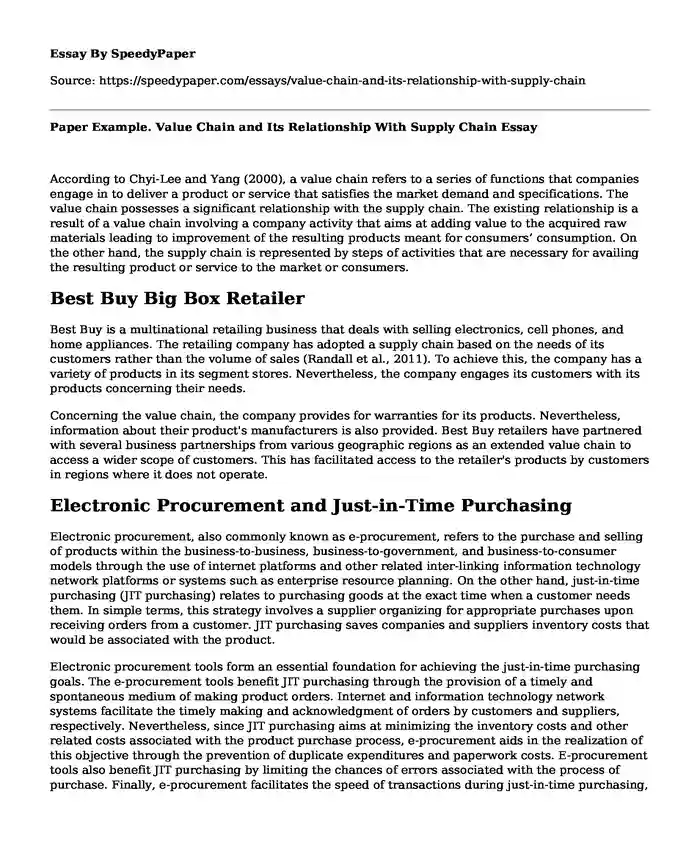
| Essay type: | Rhetorical analysis essays |
| Categories: | Marketing Sales Supply chain management Customer service |
| Pages: | 3 |
| Wordcount: | 679 words |
According to Chyi-Lee and Yang (2000), a value chain refers to a series of functions that companies engage in to deliver a product or service that satisfies the market demand and specifications. The value chain possesses a significant relationship with the supply chain. The existing relationship is a result of a value chain involving a company activity that aims at adding value to the acquired raw materials leading to improvement of the resulting products meant for consumers’ consumption. On the other hand, the supply chain is represented by steps of activities that are necessary for availing the resulting product or service to the market or consumers.
Best Buy Big Box Retailer
Best Buy is a multinational retailing business that deals with selling electronics, cell phones, and home appliances. The retailing company has adopted a supply chain based on the needs of its customers rather than the volume of sales (Randall et al., 2011). To achieve this, the company has a variety of products in its segment stores. Nevertheless, the company engages its customers with its products concerning their needs.
Concerning the value chain, the company provides for warranties for its products. Nevertheless, information about their product's manufacturers is also provided. Best Buy retailers have partnered with several business partnerships from various geographic regions as an extended value chain to access a wider scope of customers. This has facilitated access to the retailer's products by customers in regions where it does not operate.
Electronic Procurement and Just-in-Time Purchasing
Electronic procurement, also commonly known as e-procurement, refers to the purchase and selling of products within the business-to-business, business-to-government, and business-to-consumer models through the use of internet platforms and other related inter-linking information technology network platforms or systems such as enterprise resource planning. On the other hand, just-in-time purchasing (JIT purchasing) relates to purchasing goods at the exact time when a customer needs them. In simple terms, this strategy involves a supplier organizing for appropriate purchases upon receiving orders from a customer. JIT purchasing saves companies and suppliers inventory costs that would be associated with the product.
Electronic procurement tools form an essential foundation for achieving the just-in-time purchasing goals. The e-procurement tools benefit JIT purchasing through the provision of a timely and spontaneous medium of making product orders. Internet and information technology network systems facilitate the timely making and acknowledgment of orders by customers and suppliers, respectively. Nevertheless, since JIT purchasing aims at minimizing the inventory costs and other related costs associated with the product purchase process, e-procurement aids in the realization of this objective through the prevention of duplicate expenditures and paperwork costs. E-procurement tools also benefit JIT purchasing by limiting the chances of errors associated with the process of purchase. Finally, e-procurement facilitates the speed of transactions during just-in-time purchasing, thereby improving business confidence and trust.
Differences and Key Objectives of Involving Purchasing After Completion of the New Product Development Process
This strategy relates to the involvement of suppliers' contributions and services upon completion of the new product development process. It possesses the key objective of providing information that relates to whether the product specifications and design meet consumer demands. Additionally, this strategy provides producers with information concerning the number of products that are desired by the intended market.
Differences and Key Objectives of Involving Purchasing Throughout the New Product Development Process
According to this strategy, purchases, and related services from supply chain stakeholders such as suppliers are incorporated during the entire process of developing a new product. It aims to incorporate suppliers' contributions during the entire process of new product development. It serves the main objective of constantly updating the producers of any emerging change in customer's product specification preferences. As a result, these changes are adopted before introducing the final product to the market for consumption. Additionally, this strategy aims to inform the producers of other emerging technologies and products from competitors within the industry.
References
Chyi Lee, C., & Yang, J. (2000). Knowledge value chain. Journal of Management Development, 19(9), 783-794. https://doi.org/10.1108/02621710010378228
Randall, W. S., Gibson, B. J., Clifford Defee, C., &Williams, B. D. (2011). Retail supply chain management: Key priorities and practices. The International Journal of Logistics Management, 22(3), 390-402. https://doi.org/10.1108/09574091111181381
Cite this page
Paper Example. Value Chain and Its Relationship With Supply Chain. (2023, Aug 23). Retrieved from https://speedypaper.net/essays/value-chain-and-its-relationship-with-supply-chain
Request Removal
If you are the original author of this essay and no longer wish to have it published on the SpeedyPaper website, please click below to request its removal:
- Free Essay with Job Description of Accounting and Auditing Department Manager
- Essay Example on Lufthansa and Emirates Airline Competition
- Free Essay Sample on 2008 Economic Crisis
- Budgeting Essay Example: Cost Estimation Tools and Techniques
- Essay Example. Economic and Monetary Policy
- Conflicts in a Team - Free Essay
- K-12 Teachers Should Be Paid More - Free Essay
Popular categories




